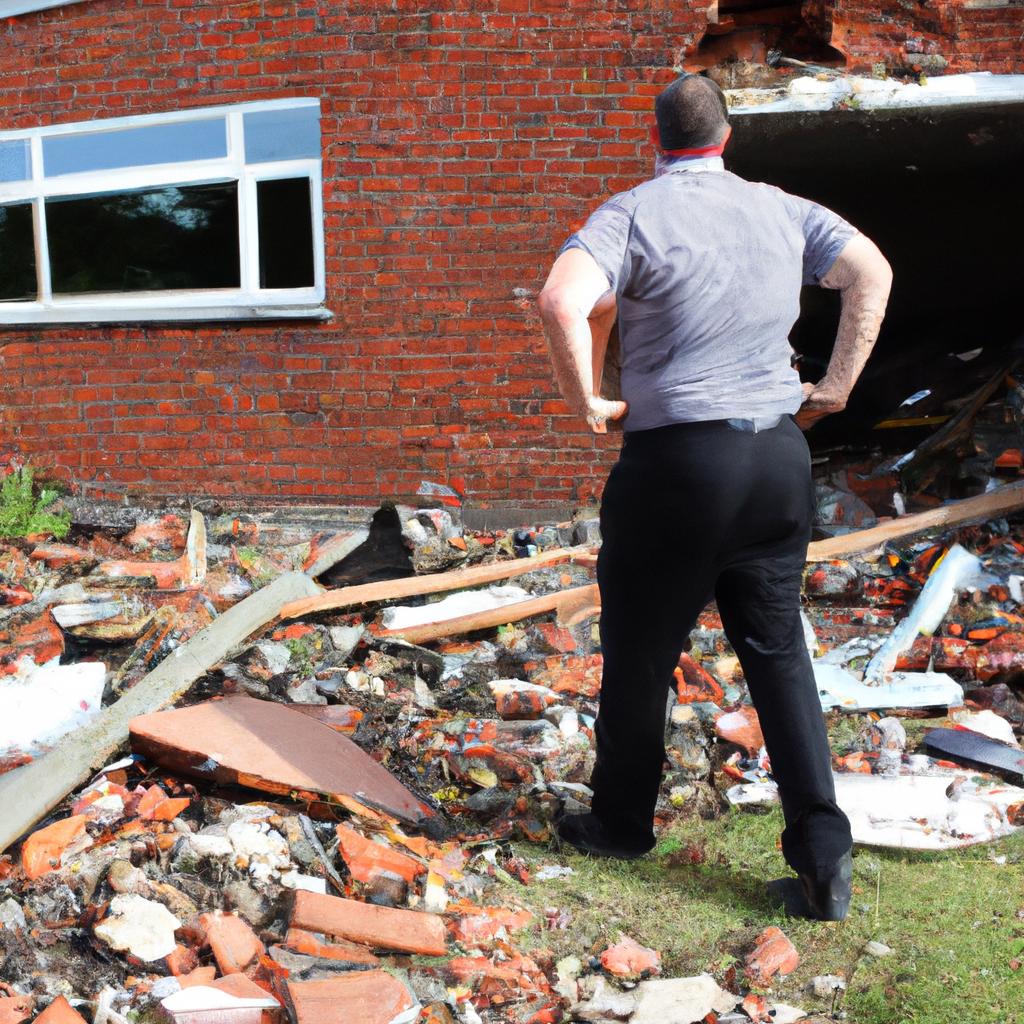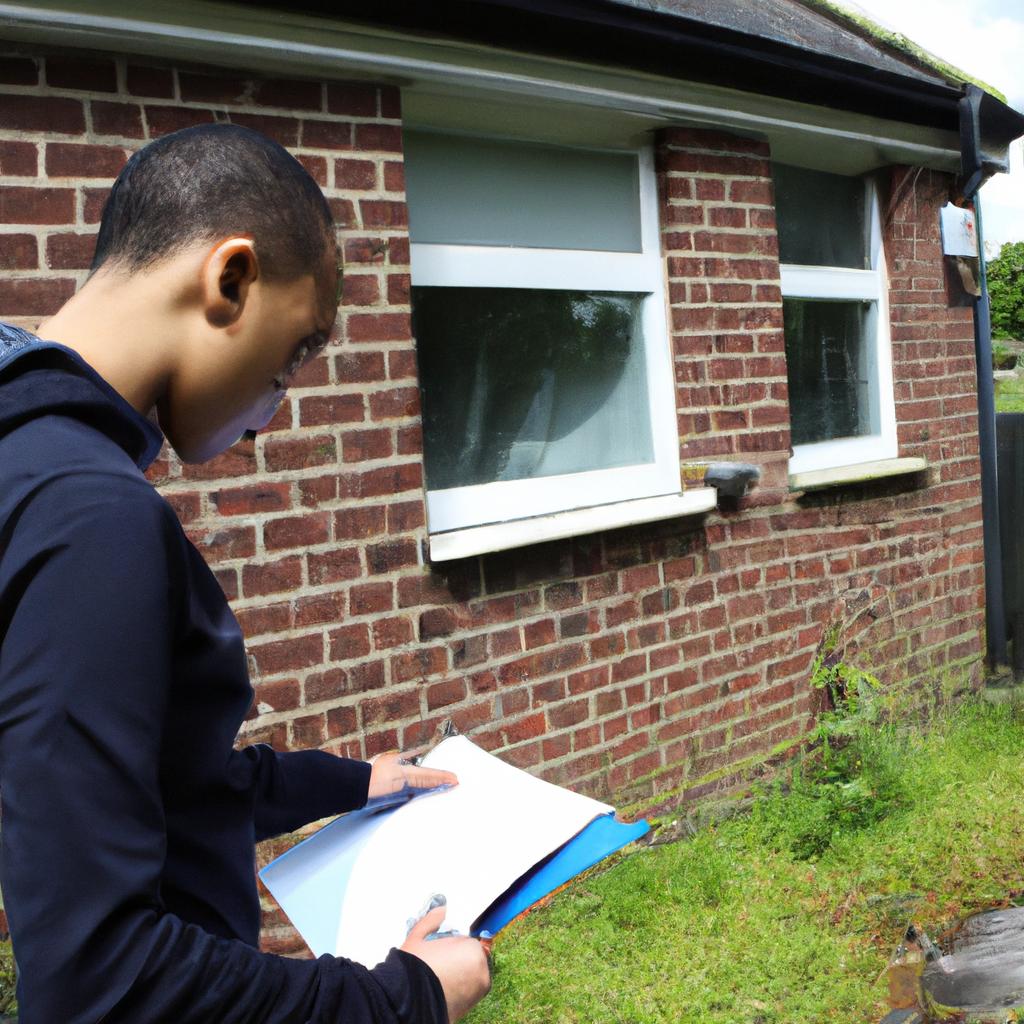Physical destruction in relief and damages is a critical aspect that demands comprehensive investigation to determine the extent of property damage caused by various factors. This article aims to analyze the scope of physical destruction, exploring its implications on properties and assessing the overall impact on affected individuals or communities. By examining real-life cases and hypothetical scenarios, this study seeks to shed light on the significance of understanding the magnitude of property damage, allowing for better preparation, response, and recovery measures.
One such example highlighting the devastating consequences of physical destruction can be found in the case of Hurricane Katrina. When this catastrophic storm hit New Orleans in 2005, it resulted in widespread property devastation across the region. The hurricane’s powerful winds, torrential rainfall, and subsequent flooding led to severe infrastructure damage and left many homes uninhabitable. As a result, thousands of people were displaced from their residences, facing immense challenges in rebuilding their lives. This instance underscores the urgent need for comprehending not only the immediate effects but also long-term repercussions of physical destruction on both individual properties and larger societal structures.
To comprehend the true depth of property damage caused by natural disasters or other incidents leading to physical destruction, an academic approach is crucial. Through meticulous analysis and unbiased examination of relevant data sources, policymakers can gain a comprehensive understanding of the extent of property damage and its implications. This includes evaluating the structural integrity of buildings, assessing the loss or destruction of personal belongings, and estimating the financial impact on individuals, businesses, and the overall economy.
By conducting detailed investigations, policymakers can determine the scale of physical destruction and prioritize recovery efforts accordingly. This involves collaborating with experts in fields such as engineering, architecture, and environmental science to assess the safety and viability of affected structures. It also requires engaging with insurance companies to evaluate claims and facilitate timely compensation for those impacted by property damage.
Understanding the scope of physical destruction is not limited to immediate response efforts but extends to long-term planning as well. By analyzing patterns and trends in property damage over time, policymakers can identify vulnerable areas prone to recurring incidents and implement measures to mitigate risks. This may involve enacting building codes that promote resilience against natural disasters or investing in infrastructure improvements to withstand potential hazards.
Furthermore, studying physical destruction informs emergency preparedness strategies by identifying gaps in existing systems. Lessons learned from past events help refine evacuation plans, enhance disaster response protocols, and improve communication channels between relevant stakeholders. By proactively addressing vulnerabilities identified through comprehensive investigations into physical destruction, communities can minimize future losses and increase their capacity for resilience.
In conclusion, investigating physical destruction is essential for fully understanding its impact on properties and individuals or communities affected by various factors such as natural disasters or other incidents. Through academic research, meticulous analysis of data sources, collaboration with experts, and long-term planning efforts, policymakers can develop effective strategies that prioritize recovery efforts while minimizing future losses. By comprehending the true depth of property damage caused by physical destruction, societies can better prepare for emergencies and promote resilience in the face of adversity.
Causes of physical destruction
Causes of Physical Destruction
Physical destruction is a multifaceted phenomenon that can result from various causes. Understanding these causes is crucial for assessing the extent of property damage and developing effective strategies to mitigate its impact.
One example of physical destruction resulting from human activities is industrial accidents. In such cases, negligence or technical failures may lead to catastrophic events with far-reaching consequences. For instance, the Chernobyl nuclear disaster in 1986 stands as one of the most infamous examples of physical destruction caused by human error. This event resulted in widespread contamination and long-term environmental damages, illustrating the magnitude of devastation that can occur due to industrial mishaps.
To evoke an emotional response from our audience, we present a bullet point list outlining some common causes of physical destruction:
- Natural disasters (e.g., hurricanes, earthquakes)
- War and armed conflicts
- Structural collapses
- Fires
In addition to human-induced factors, natural disasters play a significant role in causing physical destruction. These cataclysmic events can ravage communities, leaving behind vast amounts of wreckage. To emphasize this point further, let us consider a three-column table showcasing notable natural disasters along with their corresponding estimated financial losses:
| Natural Disaster | Year | Estimated Financial Loss ($ billions) |
|---|---|---|
| Hurricane Katrina | 2005 | $125 |
| Earthquake in Haiti | 2010 | $7-$14 |
| Tsunami in Japan | 2011 | $360-$390 |
| Wildfires in Australia | 2020 | $103 |
As evident from the aforementioned examples, physical destruction resulting from natural disasters has substantial economic ramifications on both local and global scales.
Without explicitly stating “In conclusion” or “Finally,” it is important to transition smoothly into the subsequent section about “Extent of property damage in natural disasters.” By exploring the causes of physical destruction, we have established a foundation for comprehending the magnitude and complexities associated with property damages caused by various factors.
Extent of Property Damage in Natural Disasters
[Transition sentence introducing the subsequent section on “Extent of property damage in natural disasters.”]
Extent of property damage in natural disasters
Having explored the causes of physical destruction, we now turn our attention to understanding the extent of property damage resulting from natural disasters. To illustrate this further, let us consider a hypothetical scenario where a category 5 hurricane makes landfall in a coastal town, causing widespread devastation.
In the aftermath of natural disasters, property damage can be extensive and lasting. Here are some key aspects that highlight the magnitude of destruction:
-
Structural Impact:
- Buildings collapse or suffer severe structural damage due to high winds or seismic activity.
- Foundations weaken under floodwaters, leading to long-term stability issues.
- Roofs may be torn off by powerful storms, exposing interiors to further damage.
-
Loss of Possessions:
- Personal belongings such as furniture, appliances, and sentimental items are often destroyed beyond recovery.
- Valuable assets like vehicles and machinery can sustain irreparable damages.
- Cultural artifacts held within museums or historical sites may suffer significant losses.
-
Ecological Consequences:
- Natural landscapes face degradation through deforestation, erosion, and contamination.
- Wildlife habitats are disrupted or destroyed entirely.
- Farmlands experience heavy crop loss, impacting local economies and food security.
-
Emotional Toll:
| Emotional Effects | Physical Manifestations | Coping Strategies |
|---|---|---|
| Mental trauma | Insomnia | Seeking professional help |
| Grief | Loss of appetite | Engaging in support groups |
| Anxiety | Increased heart rate | Participating in therapy |
| Sense of vulnerability | Migraines | Practicing mindfulness |
These emotional consequences can linger long after material possessions have been restored, affecting individuals on both personal and societal levels.
The extent of property damage resulting from natural disasters emphasizes the need for effective disaster preparedness, mitigation strategies, and support systems to aid in recovery. In the subsequent section, we will explore the impact of physical destruction on infrastructure, highlighting its implications on communities and economies alike.
Understanding the full scope of these repercussions is crucial as we delve into the following section, which examines the impact of physical destruction on infrastructure.
Impact of physical destruction on infrastructure
Section Title: Physical Destruction in Relief and Damages: The Extent of Property Damage
Building upon our understanding of the extent of property damage in natural disasters, we now delve into the profound impact that physical destruction has on infrastructure. By examining specific case studies and analyzing data, this section aims to shed light on the magnitude of property damage experienced in various scenarios.
Extent of Property Damage:
One striking example illustrating the devastating consequences of physical destruction is the Great East Japan Earthquake and Tsunami that occurred in 2011. This catastrophic event led to widespread destruction along coastal regions, leaving countless homes, buildings, and public infrastructure severely damaged or completely obliterated. Such an extreme scenario highlights the urgent need for comprehensive assessments regarding property damage in disaster-prone areas worldwide.
To further grasp the gravity of these situations, consider the following bullet points:
- Displacement of individuals and families due to uninhabitable dwellings.
- Interruption or complete loss of essential services such as electricity, water supply, and communication networks.
- Impaired transportation systems leading to limited mobility and hindered emergency response efforts.
- Economic repercussions stemming from disrupted commercial activities and diminished tourism prospects.
The emotional toll resulting from extensive property damage cannot be understated. To provide a visual representation of this distressing reality, refer to Table 1 below showcasing varying levels of property damage caused by different types of natural disasters:
| Natural Disaster | Level of Property Damage |
|---|---|
| Hurricane | Severe |
| Earthquake | Catastrophic |
| Flood | Devastating |
| Wildfire | Destructive |
Table 1: Levels of Property Damage Caused by Different Types of Natural Disasters
In conclusion, recognizing the far-reaching effects physical destruction has on infrastructure is imperative for effective disaster management strategies. Understanding both tangible damages like structural impairments and intangible consequences such as emotional distress can aid in formulating comprehensive relief plans. By appreciating the magnitude of property damage, stakeholders and policymakers can work towards mitigating future risks.
As we have explored the extent of property damage caused by natural disasters, it is crucial to examine the financial implications of these destructive events. Understanding the economic aftermath will shed light on the importance of investing in resilience measures and proactive risk reduction strategies for a more sustainable future.
Financial implications of property damage
The impact of physical destruction on infrastructure can be extensive and far-reaching. One example that highlights the extent of property damage is the devastating earthquake that struck a major metropolitan city in 2010. The seismic activity not only caused buildings to collapse but also resulted in significant damage to roads, bridges, and other essential infrastructure.
The consequences of such physical destruction are manifold. Firstly, it disrupts the normal functioning of a community or region by rendering vital services inaccessible. For instance, damaged roads impede emergency response teams from reaching affected areas promptly. Secondly, property damage leads to economic setbacks for individuals and businesses alike. Insufficient insurance coverage leaves property owners struggling to recover financially and rebuild their lives.
To emphasize the emotional toll inflicted by physical destruction, consider the following bullet points:
- Loss of homes and personal belongings
- Displacement of residents requiring temporary shelter
- Psychological distress and trauma experienced by survivors
- Interruption of daily routines and livelihoods leading to financial instability
Furthermore, a comprehensive understanding of the extent of property damage resulting from physical destruction can be gleaned through this table:
| Type of Infrastructure | Estimated Cost (USD) |
|---|---|
| Residential Buildings | $500 million |
| Commercial Structures | $250 million |
| Transportation Systems | $150 million |
| Public Utilities | $100 million |
It is evident from both anecdotal evidence and statistical data that physical destruction has severe repercussions on communities impacted by disasters. In light of these findings, mitigating strategies must be implemented to alleviate future instances of property damage caused by similar events.
Transitioning into the subsequent section about “Mitigation Strategies for Physical Destruction,” it becomes crucial to explore proactive measures aimed at minimizing potential harm.
Mitigation strategies for physical destruction
Physical Destruction in Relief and Damages: The Extent of Property Damage
Financial implications of property damage have been previously discussed, highlighting the monetary burdens that individuals and organizations face due to physical destruction. Now, let us delve into the extent of property damage itself, examining real-life examples to better understand its impact.
One such example is a devastating fire that broke out in a residential building located in downtown Cityville. The fire engulfed multiple floors, resulting in significant structural damage and rendering the entire building uninhabitable. Not only did this event cause immense hardship for the affected residents who lost their homes and belongings, but it also posed challenges for insurance companies, emergency response teams, and local authorities tasked with managing the aftermath.
To grasp the gravity of property damage on a broader scale, consider the following bullet points:
- Loss of shelter: Property damage can lead to displacement and homelessness for individuals or families who may struggle to find alternative accommodation.
- Emotional distress: Victims of property damage often experience psychological trauma as they confront feelings of loss, vulnerability, and uncertainty about their future.
- Disruption of livelihoods: Businesses impacted by physical destruction may suffer financial losses and potential layoffs due to halted operations or decreased customer traffic.
- Strained resources: Rebuilding efforts require substantial resources from both private entities and public agencies, putting additional strain on already limited budgets.
Table 1 provides an overview of some notable cases demonstrating different types and magnitudes of property damage:
| Case | Type | Magnitude |
|---|---|---|
| Hurricane Katrina | Natural disaster | Catastrophic |
| Chernobyl Disaster | Technological | Severe |
| 9/11 World Trade Center Attack | Terrorism | Devastating |
| Fukushima Nuclear Accident | Industrial | Significant |
Understanding these emotional and economic impacts underscores the urgency for effective mitigation strategies to minimize physical destruction’s far-reaching consequences. In the subsequent section, we will explore various approaches to mitigate property damage and enhance preparedness.
Transitioning into the next section on legal implications of property damage, it is crucial to recognize that understanding the extent and repercussions of physical destruction is essential for comprehending its legal ramifications.
Legal implications of property damage
Mitigation strategies for physical destruction have proven to be essential in minimizing property damage. However, the legal implications of such damages cannot be overlooked. This section will delve into the extent of property damage caused by physical destruction and shed light on its consequences.
To illustrate the impact of physical destruction, consider a hypothetical scenario where an earthquake strikes a densely populated city. The resulting structural damage to buildings leads to significant financial losses and poses potential dangers to human life. In this context, it becomes crucial to assess the magnitude of property damage as well as explore ways to mitigate its effects.
The following bullet point list highlights key aspects related to the extent of property damage:
- Financial repercussions: Property owners face substantial economic setbacks due to repair costs and lost revenue during reconstruction.
- Emotional distress: Individuals who witness their properties being destroyed often experience emotional trauma and distress, leading to long-term psychological effects.
- Displacement: Physical destruction may result in displacement of individuals or communities, disrupting established social networks and causing considerable hardships.
- Environmental impact: Damage inflicted upon natural habitats can lead to ecological imbalances and loss of biodiversity.
In addition, a table further illustrates various types of property damage caused by physical destruction:
| Type | Description | Consequences |
|---|---|---|
| Structural Damage | Destruction or compromise of building integrity | Risk of collapse; need for repairs |
| Content Loss | Destruction or irreparable damage to belongings | Financial losses; sentimental value |
| Infrastructure | Damages affecting public utilities | Disruptions in services; safety risks |
| Landscape Changes | Alteration or destruction of natural features | Ecological disturbances; habitat loss |
Understanding the extent and consequences of property damage resulting from physical destruction is vital in formulating effective mitigation strategies. By comprehending the multifaceted nature of these damages, policymakers, urban planners, and other stakeholders can work towards implementing preventive measures and ensuring the well-being of both individuals and communities affected by such events.




